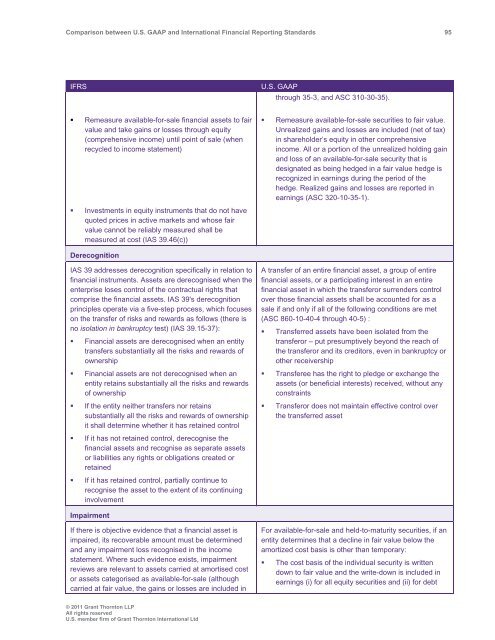Comparison between U.S. GAAP and International ... - Grant Thornton
Comparison between U.S. GAAP and International ... - Grant Thornton
Comparison between U.S. GAAP and International ... - Grant Thornton
Create successful ePaper yourself
Turn your PDF publications into a flip-book with our unique Google optimized e-Paper software.
<strong>Comparison</strong> <strong>between</strong> U.S. <strong>GAAP</strong> <strong>and</strong> <strong>International</strong> Financial Reporting St<strong>and</strong>ards 95<br />
IFRS<br />
U.S. <strong>GAAP</strong><br />
through 35-3, <strong>and</strong> ASC 310-30-35).<br />
• Remeasure available-for-sale financial assets to fair<br />
value <strong>and</strong> take gains or losses through equity<br />
(comprehensive income) until point of sale (when<br />
recycled to income statement)<br />
• Investments in equity instruments that do not have<br />
quoted prices in active markets <strong>and</strong> whose fair<br />
value cannot be reliably measured shall be<br />
measured at cost (IAS 39.46(c))<br />
• Remeasure available-for-sale securities to fair value.<br />
Unrealized gains <strong>and</strong> losses are included (net of tax)<br />
in shareholder’s equity in other comprehensive<br />
income. All or a portion of the unrealized holding gain<br />
<strong>and</strong> loss of an available-for-sale security that is<br />
designated as being hedged in a fair value hedge is<br />
recognized in earnings during the period of the<br />
hedge. Realized gains <strong>and</strong> losses are reported in<br />
earnings (ASC 320-10-35-1).<br />
Derecognition<br />
IAS 39 addresses derecognition specifically in relation to<br />
financial instruments. Assets are derecognised when the<br />
enterprise loses control of the contractual rights that<br />
comprise the financial assets. IAS 39's derecognition<br />
principles operate via a five-step process, which focuses<br />
on the transfer of risks <strong>and</strong> rewards as follows (there is<br />
no isolation in bankruptcy test) (IAS 39.15-37):<br />
• Financial assets are derecognised when an entity<br />
transfers substantially all the risks <strong>and</strong> rewards of<br />
ownership<br />
• Financial assets are not derecognised when an<br />
entity retains substantially all the risks <strong>and</strong> rewards<br />
of ownership<br />
• If the entity neither transfers nor retains<br />
substantially all the risks <strong>and</strong> rewards of ownership<br />
it shall determine whether it has retained control<br />
• If it has not retained control, derecognise the<br />
financial assets <strong>and</strong> recognise as separate assets<br />
or liabilities any rights or obligations created or<br />
retained<br />
• If it has retained control, partially continue to<br />
recognise the asset to the extent of its continuing<br />
involvement<br />
A transfer of an entire financial asset, a group of entire<br />
financial assets, or a participating interest in an entire<br />
financial asset in which the transferor surrenders control<br />
over those financial assets shall be accounted for as a<br />
sale if <strong>and</strong> only if all of the following conditions are met<br />
(ASC 860-10-40-4 through 40-5) :<br />
• Transferred assets have been isolated from the<br />
transferor – put presumptively beyond the reach of<br />
the transferor <strong>and</strong> its creditors, even in bankruptcy or<br />
other receivership<br />
• Transferee has the right to pledge or exchange the<br />
assets (or beneficial interests) received, without any<br />
constraints<br />
• Transferor does not maintain effective control over<br />
the transferred asset<br />
Impairment<br />
If there is objective evidence that a financial asset is<br />
impaired, its recoverable amount must be determined<br />
<strong>and</strong> any impairment loss recognised in the income<br />
statement. Where such evidence exists, impairment<br />
reviews are relevant to assets carried at amortised cost<br />
or assets categorised as available-for-sale (although<br />
carried at fair value, the gains or losses are included in<br />
For available-for-sale <strong>and</strong> held-to-maturity securities, if an<br />
entity determines that a decline in fair value below the<br />
amortized cost basis is other than temporary:<br />
• The cost basis of the individual security is written<br />
down to fair value <strong>and</strong> the write-down is included in<br />
earnings (i) for all equity securities <strong>and</strong> (ii) for debt<br />
© 2011 <strong>Grant</strong> <strong>Thornton</strong> LLP<br />
All rights reserved<br />
U.S. member firm of <strong>Grant</strong> <strong>Thornton</strong> <strong>International</strong> Ltd
















